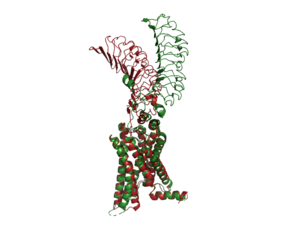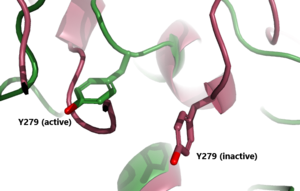Sandbox Reserved 1791
From Proteopedia
(Difference between revisions)
| Line 11: | Line 11: | ||
TSHR has 3 main domains</scene>: Leucine Rich Region Domain (coral), the hinge region (blue-purple), and the transmembrane region(rainbow). The leucine rich region domain is the extracellular TSH ligand domain. The hinge connects the Leucine Rich Repeat Domain and the Transmembrane Region. It provides flexibility for the switch between the active and inactive state of TSHR. The transmembrane region is located within the plasma membrane. Its function transmit the extracellular signal across the membrane to the intracellular [https://en.wikipedia.org/wiki/G_protein G-proteins] bound to the N-terminus of the transmembrane region<ref name="Duan"/>. Activated G-proteins then signal a robust intracellular signaling cascade. | TSHR has 3 main domains</scene>: Leucine Rich Region Domain (coral), the hinge region (blue-purple), and the transmembrane region(rainbow). The leucine rich region domain is the extracellular TSH ligand domain. The hinge connects the Leucine Rich Repeat Domain and the Transmembrane Region. It provides flexibility for the switch between the active and inactive state of TSHR. The transmembrane region is located within the plasma membrane. Its function transmit the extracellular signal across the membrane to the intracellular [https://en.wikipedia.org/wiki/G_protein G-proteins] bound to the N-terminus of the transmembrane region<ref name="Duan"/>. Activated G-proteins then signal a robust intracellular signaling cascade. | ||
=== Leucine Rich Domain=== | === Leucine Rich Domain=== | ||
| - | The <scene name='95/952719/Lrrd/1'>Leucine Rich Repeat Domain (LRRD)</scene> is the extracellular ligand binding region of TSHR. Connects to the Hinge Region at its C-terminus. It is made up of polar residues in a concave parallel β-sheet where TSH binds and is called the <scene name='95/952719/Binding_pocket/7'>binding pocket</scene><ref name="Duan"> DOI 10.1038/s41586-022-05173-3</ref>. | + | The <scene name='95/952719/Lrrd/1'>Leucine Rich Repeat Domain (LRRD)</scene> is the extracellular ligand binding region of TSHR. Connects to the Hinge Region at its C-terminus. It is made up of polar residues in a concave parallel β-sheet composed of leucine-rich repeats where TSH binds and is called the <scene name='95/952719/Binding_pocket/7'>binding pocket</scene><ref name="Duan"> DOI 10.1038/s41586-022-05173-3</ref>. The LRRD concave surface is where the TSH antibody antagonist, K1, binds as well as the agonist M22. Two specific LYS residues interact with the substrate to result in a structural change of the molecule. N-glycans attached to asparagine residues play a large role in the binding of TSH. Negative charge on these N glycans contributes to the polarity of the binding pocket which mediates the binding efficiency of TSH. Four of the five N glycan sites must be glycosylated for TSHR to be in the active form<ref name="Fokina">Fokina, E.F., Shpakov, A.O. Thyroid-Stimulating Hormone Receptor: the Role in the Development of Thyroid Pathology and Its Correction. J Evol Biochem Phys 58, 1439–1454 (2022). [DOI:10.1134/S0022093022050143 https://doi.org/10.1134/S0022093022050143]</ref>. |
=== Hinge Region=== | === Hinge Region=== | ||
The <scene name='95/952719/Hinge_region_spin/3'>Higne Region</scene>(purple-blue) connects the Transmembrane Region to the Leucine Rich Domain. It is sometimes referred to as the signaling specificity domain because there is some evidence suggesting that this region is important in both TSH binding and signal transduction. <ref name="Chen">Chen CR, McLachlan SM, Rapoport B. Thyrotropin (TSH) receptor residue E251 in the extracellular leucine-rich repeat domain is critical for linking TSH binding to receptor activation. Endocrinology. 2010 Apr;151(4):1940-7. doi: 10.1210/en.2009-1430. Epub 2010 Feb 24. PMID: 20181794; PMCID: PMC2851189. [DOI 10.1210/en.2009-1430 https://www.ncbi.nlm.nih.gov/pmc/articles/PMC2851189/]</ref>. It is made up of two α-helices that are connected via disulfide bonds(shown in yellow). Interactions between these two helices and TSH help orient TSH properly. These interactions are essential for TSH binding, however, they are not required for the activation of TSHR. Conformational changes in this region, specifically the orientation of <scene name='95/952719/Hinge_region_residues/3'>Y279</scene>(shown in active state), are responsible for bringing TSHR into the active state <ref name="Faust"/>. | The <scene name='95/952719/Hinge_region_spin/3'>Higne Region</scene>(purple-blue) connects the Transmembrane Region to the Leucine Rich Domain. It is sometimes referred to as the signaling specificity domain because there is some evidence suggesting that this region is important in both TSH binding and signal transduction. <ref name="Chen">Chen CR, McLachlan SM, Rapoport B. Thyrotropin (TSH) receptor residue E251 in the extracellular leucine-rich repeat domain is critical for linking TSH binding to receptor activation. Endocrinology. 2010 Apr;151(4):1940-7. doi: 10.1210/en.2009-1430. Epub 2010 Feb 24. PMID: 20181794; PMCID: PMC2851189. [DOI 10.1210/en.2009-1430 https://www.ncbi.nlm.nih.gov/pmc/articles/PMC2851189/]</ref>. It is made up of two α-helices that are connected via disulfide bonds(shown in yellow). Interactions between these two helices and TSH help orient TSH properly. These interactions are essential for TSH binding, however, they are not required for the activation of TSHR. Conformational changes in this region, specifically the orientation of <scene name='95/952719/Hinge_region_residues/3'>Y279</scene>(shown in active state), are responsible for bringing TSHR into the active state <ref name="Faust"/>. | ||
=== Transmembrane Region=== | === Transmembrane Region=== | ||
| - | <scene name='95/952720/Transmembrane_region_spin/5'>The Transmembrane Region</scene> (<scene name='95/952720/Transmembrane_region_top-view/2'>top-view</scene>) is embedded within the cell membrane, like other G-protein receptors, it is composed of a 7-pass helix <ref name="Faust"> DOI:10.1038/s41586-022-05159-1</ref>. The transmembrane region is surrounded by a "belt" of <scene name='95/952719/Tmd_cholesterol_spin/3'>15 cholesterols</scene>. When cholesterol binding sites are mutated, TSHR activity decreases. These cholesterols are likely important for TSHR function <ref name="Duan"/>. Additionally, at the N-terminus, the transmembrane region binds to the <scene name='95/952719/Tsh-tshr-gs_complex/3'>G-Proteins</scene>, which are located intracellularly <ref name="GOEL"/>. The G-proteins are made up of | + | <scene name='95/952720/Transmembrane_region_spin/5'>The Transmembrane Region</scene> (<scene name='95/952720/Transmembrane_region_top-view/2'>top-view</scene>) is embedded within the cell membrane, like other G-protein receptors, it is composed of a 7-pass helix <ref name="Faust"> DOI:10.1038/s41586-022-05159-1</ref>. The transmembrane region is surrounded by a "belt" of <scene name='95/952719/Tmd_cholesterol_spin/3'>15 cholesterols</scene>. When cholesterol binding sites are mutated, TSHR activity decreases. These cholesterols are likely important for TSHR function <ref name="Duan"/>. Additionally, at the N-terminus, the transmembrane region binds to the <scene name='95/952719/Tsh-tshr-gs_complex/3'>G-Proteins</scene>, which are located intracellularly <ref name="GOEL"/>. The G-proteins are made up of three subunits: α, β, and γ. Nb35 a fourth subunit that stabilizes the structure by binding between the Gα and Gβ interface<ref name="Maeda"> DOI: 10.1038/s41467-018-06002-w</ref>. When TSHR is activated, it causes the Gα subunit to dissociate from the Gβγ subunits. The Gα subunit is responsible for activating [https://en.wikipedia.org/wiki/Adenylyl_cyclase adenylyl cyclase], [https://en.wikipedia.org/wiki/Phospholipase_C phospholipase C], and [https://en.wikipedia.org/wiki/Ion_channel ion channels]. This sets off the robust intracellular signaling cascade<ref name="GOEL"> PMID:24255551</ref>. |
== Antibodies == | == Antibodies == | ||
[https://my.clevelandclinic.org/health/body/22971-antibodies Antibodies] are an important part of the thyroid response. These proteins are made in an immune system response to get rid of unwanted antigens in the body. [https://www.btf-thyroid.org/thyroid-antibodies-explained Thyroid antibodies] are made when the body attacks the thyroid tissues. These antibodies are made to mimic [https://my.clevelandclinic.org/health/articles/23524-thyroid-stimulating-hormone-tsh-levels TSH (Thyroid Stimulating Hormone)]. TSH is released from the pituitary gland to bind to TSHR and stimulate the thyroid to make T3 and T4 hormones to regulate the metabolism. These thyroid antibodies bind to the concave surface of the LRD. | [https://my.clevelandclinic.org/health/body/22971-antibodies Antibodies] are an important part of the thyroid response. These proteins are made in an immune system response to get rid of unwanted antigens in the body. [https://www.btf-thyroid.org/thyroid-antibodies-explained Thyroid antibodies] are made when the body attacks the thyroid tissues. These antibodies are made to mimic [https://my.clevelandclinic.org/health/articles/23524-thyroid-stimulating-hormone-tsh-levels TSH (Thyroid Stimulating Hormone)]. TSH is released from the pituitary gland to bind to TSHR and stimulate the thyroid to make T3 and T4 hormones to regulate the metabolism. These thyroid antibodies bind to the concave surface of the LRD. | ||
Revision as of 02:12, 21 April 2023
| This Sandbox is Reserved from February 27 through August 31, 2023 for use in the course CH462 Biochemistry II taught by R. Jeremy Johnson at the Butler University, Indianapolis, USA. This reservation includes Sandbox Reserved 1765 through Sandbox Reserved 1795. |
To get started:
More help: Help:Editing |
Thyroid Stimulating Hormone Receptor (TSHR)
| |||||||||||
References
- ↑ 1.0 1.1 1.2 1.3 Faust B, Billesbolle CB, Suomivuori CM, Singh I, Zhang K, Hoppe N, Pinto AFM, Diedrich JK, Muftuoglu Y, Szkudlinski MW, Saghatelian A, Dror RO, Cheng Y, Manglik A. Autoantibody mimicry of hormone action at the thyrotropin receptor. Nature. 2022 Aug 8. pii: 10.1038/s41586-022-05159-1. doi:, 10.1038/s41586-022-05159-1. PMID:35940205 doi:http://dx.doi.org/10.1038/s41586-022-05159-1
- ↑ 2.0 2.1 2.2 2.3 Duan J, Xu P, Luan X, Ji Y, He X, Song N, Yuan Q, Jin Y, Cheng X, Jiang H, Zheng J, Zhang S, Jiang Y, Xu HE. Hormone- and antibody-mediated activation of the thyrotropin receptor. Nature. 2022 Aug 8. pii: 10.1038/s41586-022-05173-3. doi:, 10.1038/s41586-022-05173-3. PMID:35940204 doi:http://dx.doi.org/10.1038/s41586-022-05173-3
- ↑ Fokina, E.F., Shpakov, A.O. Thyroid-Stimulating Hormone Receptor: the Role in the Development of Thyroid Pathology and Its Correction. J Evol Biochem Phys 58, 1439–1454 (2022). [DOI:10.1134/S0022093022050143 https://doi.org/10.1134/S0022093022050143]
- ↑ Chen CR, McLachlan SM, Rapoport B. Thyrotropin (TSH) receptor residue E251 in the extracellular leucine-rich repeat domain is critical for linking TSH binding to receptor activation. Endocrinology. 2010 Apr;151(4):1940-7. doi: 10.1210/en.2009-1430. Epub 2010 Feb 24. PMID: 20181794; PMCID: PMC2851189. [DOI 10.1210/en.2009-1430 https://www.ncbi.nlm.nih.gov/pmc/articles/PMC2851189/]
- ↑ 5.0 5.1 Goel R, Raju R, Maharudraiah J, Sameer Kumar GS, Ghosh K, Kumar A, Lakshmi TP, Sharma J, Sharma R, Balakrishnan L, Pan A, Kandasamy K, Christopher R, Krishna V, Mohan SS, Harsha HC, Mathur PP, Pandey A, Keshava Prasad TS. A Signaling Network of Thyroid-Stimulating Hormone. J Proteomics Bioinform. 2011 Oct 29;4:10.4172/jpb.1000195. PMID:24255551 doi:10.4172/jpb.1000195
- ↑ Maeda S, Koehl A, Matile H, Hu H, Hilger D, Schertler GFX, Manglik A, Skiniotis G, Dawson RJP, Kobilka BK. Development of an antibody fragment that stabilizes GPCR/G-protein complexes. Nat Commun. 2018 Sep 13;9(1):3712. doi: 10.1038/s41467-018-06002-w. PMID:30213947 doi:http://dx.doi.org/10.1038/s41467-018-06002-w
- ↑ Nunez Miguel R, Sanders J, Chirgadze DY, Furmaniak J, Rees Smith B. Thyroid stimulating autoantibody M22 mimics TSH binding to the TSH receptor leucine rich domain: a comparative structural study of protein-protein interactions. J Mol Endocrinol. 2009 May;42(5):381-95. Epub 2009 Feb 16. PMID:19221175 doi:10.1677/JME-08-0152
- ↑ Smits G, Govaerts C, Nubourgh I, Pardo L, Vassart G, Costagliola S. Lysine 183 and glutamic acid 157 of the TSH receptor: two interacting residues with a key role in determining specificity toward TSH and human CG. Mol Endocrinol. 2002 Apr;16(4):722-35. doi: 10.1210/mend.16.4.0815. PMID: 11923469. [DOI: 10.1210/mend.16.4.0815 https://pubmed.ncbi.nlm.nih.gov/11923469/]
- ↑ 9.0 9.1 Chiovato L, Magri F, Carlé A. Hypothyroidism in Context: Where We've Been and Where We're Going. Adv Ther. 2019 Sep;36(Suppl 2):47-58. doi: 10.1007/s12325-019-01080-8. Epub 2019 Sep 4. PMID: 31485975; PMCID: PMC6822815. [DOI: 10.1007/s12325-019-01080-8 https://pubmed.ncbi.nlm.nih.gov/31485975/]
![Figure 1: An overview of the Thyroid System. A depiction of signaling cascade from the hypothalamus ending in the release of TSH causing T3 and T4 production and its effects. The mechanism of regulation is also shown by negative feedback from the T3 and T4 hormones. Source: [1]](/wiki/images/thumb/1/1d/TSH_system1.png/300px-TSH_system1.png)


![Figure 4: T3 and T4 role in TSH concentration: Highlighting the problem when under or overactive on the metabolism. When an antibody is bound to TSHR and cannot respond to the negative feedback look the metabolism experiences a shift outside of equilibrium resulting in a wide array of side effects. [2]](/wiki/images/thumb/5/5f/T3t4levels.jpeg/400px-T3t4levels.jpeg)
